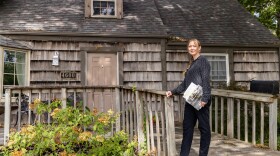The City of Austin says it will give people from gentrifying neighborhoods priority in the application process for two dozen homes it's selling to low-income families.
This is the first time the city plans to use what it calls a "preference policy," which was approved by council members in 2018. Other cities, including Portland, have prioritized affordable housing for low-income people displaced from their neighborhoods. Policies like these are also referred to as "right-to-return."
“This is hugely exciting,” Council Member Paige Ellis, who represents Southwest Austin, said at a council committee meeting Tuesday.
Staff with the city’s Housing and Planning Department originally said they would begin using this preference policy back in 2019. A spokesperson for the department said, however, the pandemic delayed hiring needed to implement it.
To benefit from the program, people first need to be making less than Austin's family median income; for a single-person household that amounts to $69,250 a year.
Additionally, people need to prove they've been affected by gentrification or that they have generational ties to the city. That can mean they live or have lived — as far back as 2000 — in a neighborhood in the process of gentrifying; that's the process in which wealthy people move to a historically middle- or low-income neighborhood and housing costs rise. The city is using a study published in 2018 to identify parts of Austin affected by gentrification. These neighborhoods include portions of St. Johns, E. Cesar Chavez, S. Lamar and Rundberg, plus large swaths of East Austin and Southeast Austin, around the airport.
City staff said applications will open this month, but they have not set an exact date.
Based off several other questions, applicants will receive an overall score, and then be offered the opportunity to qualify for a mortgage and buy a home owned by the city’s affordable housing arm.
The city has 24 properties available, all of which will be run as what’s called a community land trust. This is where a government entity or a nonprofit owns the land and sells only the house, keeping the price of the home lower than if it were to be sold in the traditional market. (Land in Austin is expensive, with empty parcels sometimes listed for more than $200,000.)
This allows the city to price homes way below market rate. The first home the city will sell is a three-bedroom, two-bathroom home in East Austin; while the median sales price of a home in Austin hit $565,000 earlier this year, this house will sell for $221,000.
Although this policy, in part, focuses on people displaced from changing neighborhoods, those who apply won't necessarily be able to return to those neighborhoods; it will depend on the location of the homes available. Many of the properties the city has to sell are in Northwest Austin, not East Austin, where much of the effects of gentrification have been felt.
“What we have are homes that are scatterplot,” Chanda Gaither, a program manager with Austin’s Housing and Planning Department, told KUT. She said the goal is to return people to the city as a whole — not to a specific part of town.
“That would have meant we had thought about this far enough in advance that we had land set aside from all of East Austin,” she said. “And we do not.”
Elizabeth Mueller, an associate professor of regional and community planning at UT Austin, said while a policy like this is interesting, it’s not necessarily a perfect solution to gentrification.
“As a remedy or solution to things that happened a long time ago, it’s not ideal because people obviously left probably a long time ago. Their connection to the area may not be as strong,” Mueller told KUT. “It raises the issue of what are they returning to?”
Correction: An earlier version of this story stated that the city had 28 homes to sell. A city staffer clarified later that she misspoke, and the number is actually 24.





















